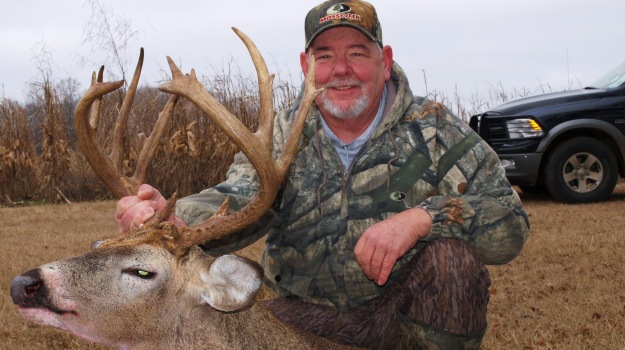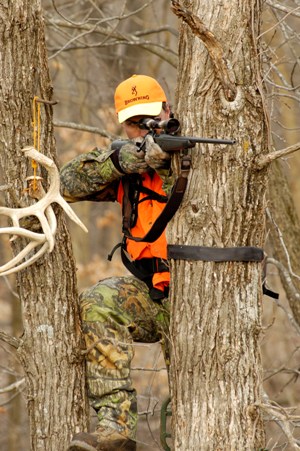
Editor’s Note: Ronnie “Cuz” Strickland, today the vice president of Mossy Oak in charge of television and video production, may have filmed more TV shows and videos about hunting and the outdoors than anyone in the industry. Currently Cuz is responsible for producing these TV shows, including “Hunting the Country,” “Deer Thugs,” “Turkey Thugs,” “Inside the Obsession” and “GameKeepers,” as well as all the videos that Mossy Oak produces. A growing number of sportsmen who hunt together trade off between being the videographer and being the hunter. Good video cameras are less expensive today than they ever have been, besides being smaller, lighter and easier to use. Often today hunters don’t tell the stories of their hunts to friends and family but instead show the videos of their hunts. To provide this new breed of video hunters and shooters with the best information available, we’ve asked Ronnie Strickland to tell us how to avoid the most-common mistakes that most video hunters make, when they’re trying to film a hunt.
You have to mentally make the transition from not being the hunter to being the field producer when videoing a hunt. I have to tell myself every morning, when I go out to video a hunt that, “My only reason for being on this hunt is to get the best video I possibly can get. I am not out there to be watching birds and squirrels in the tree, watching deer on a green field or calling to any animals. My number-one job is to get the video.”
 You have to have a plan. You need to know what you’ll do when certain things happen. For instance, when the hunter shoots the animal, are you going to try and follow the animal, or will you focus on the hunter? If you’re following the animal, then just as the hunter takes the shot, you need to be panning back (getting a wider field of view) to show more of the woods where the animal will be running. If you zoom-in close on the animal at this point, there is no way you’ll be able to stay closely zoomed-in and follow the animal. So, practice zooming back. Once you get in your stand, focus on a stump or a bush as though it’s the animal. Practice zooming out (getting a wider field of view) as quickly as a shot will be taken. Every day you need to practice. You need to say to yourself, “If the hunter takes the shot here, I’ll have to turn the camera to the left or to the right. At the same time, I need to get a wider view than I’ve had when the hunter’s released the arrow or pulled the trigger.”
You have to have a plan. You need to know what you’ll do when certain things happen. For instance, when the hunter shoots the animal, are you going to try and follow the animal, or will you focus on the hunter? If you’re following the animal, then just as the hunter takes the shot, you need to be panning back (getting a wider field of view) to show more of the woods where the animal will be running. If you zoom-in close on the animal at this point, there is no way you’ll be able to stay closely zoomed-in and follow the animal. So, practice zooming back. Once you get in your stand, focus on a stump or a bush as though it’s the animal. Practice zooming out (getting a wider field of view) as quickly as a shot will be taken. Every day you need to practice. You need to say to yourself, “If the hunter takes the shot here, I’ll have to turn the camera to the left or to the right. At the same time, I need to get a wider view than I’ve had when the hunter’s released the arrow or pulled the trigger.”
Most athletes mentally picture themselves being successful. The high jumper mentally sees himself running toward the bar, jumping, his legs coming up, his body going over the bar, the excitement of landing on the mat and the bar staying still, signifying a successful jump. If you don’t do your metal gymnastics and prepare each day ahead of time with focusing on the animal where you think he will be when you take the shot, then, zooming-out, getting a wider field of view and turning your camera to the left or right like you’re following the animal, then you won’t be able to make these instant decisions, when the hunter makes the shot.
Because deer don’t read scripts, you have to be prepared for the animal of a lifetime to possibly appear around your stand. Before you see the animal, you need to be looking and thinking about how:
- will I get into position, if the animal comes in on my far right?
- will I get the shot, if the animal comes in on my far left?
- can I get the animal in the viewfinder, if it walks right under my stand?
- will I video the animal, if it’s standing in the brush 70- or 80-yards away?
While you’re in the tree stand, you have to go through the mental gymnastics of what you’ll do, how you’ll move the camera, and what you’ll need to video the critter that comes in from any direction around your tree stand. This mentally thinking through the shot may seem like a burden, but remember. For the hunt to be successful, the hunter has to go through these same mental gymnastics. This is one of the reasons I always say that training a hunter to be a field producer is easier than training a videographer to be a hunter with his camera.
The bottom line is: when it’s your day to run the camera, before you leave camp, as soon as you climb into your stand and during the entire hunt, commit to being the field producer. Be constantly thinking about, “How can I get the best video possible on this day?”
Day 4: Using Automatic Focus on a Camera is the Kiss Of Death for the Videographer






























